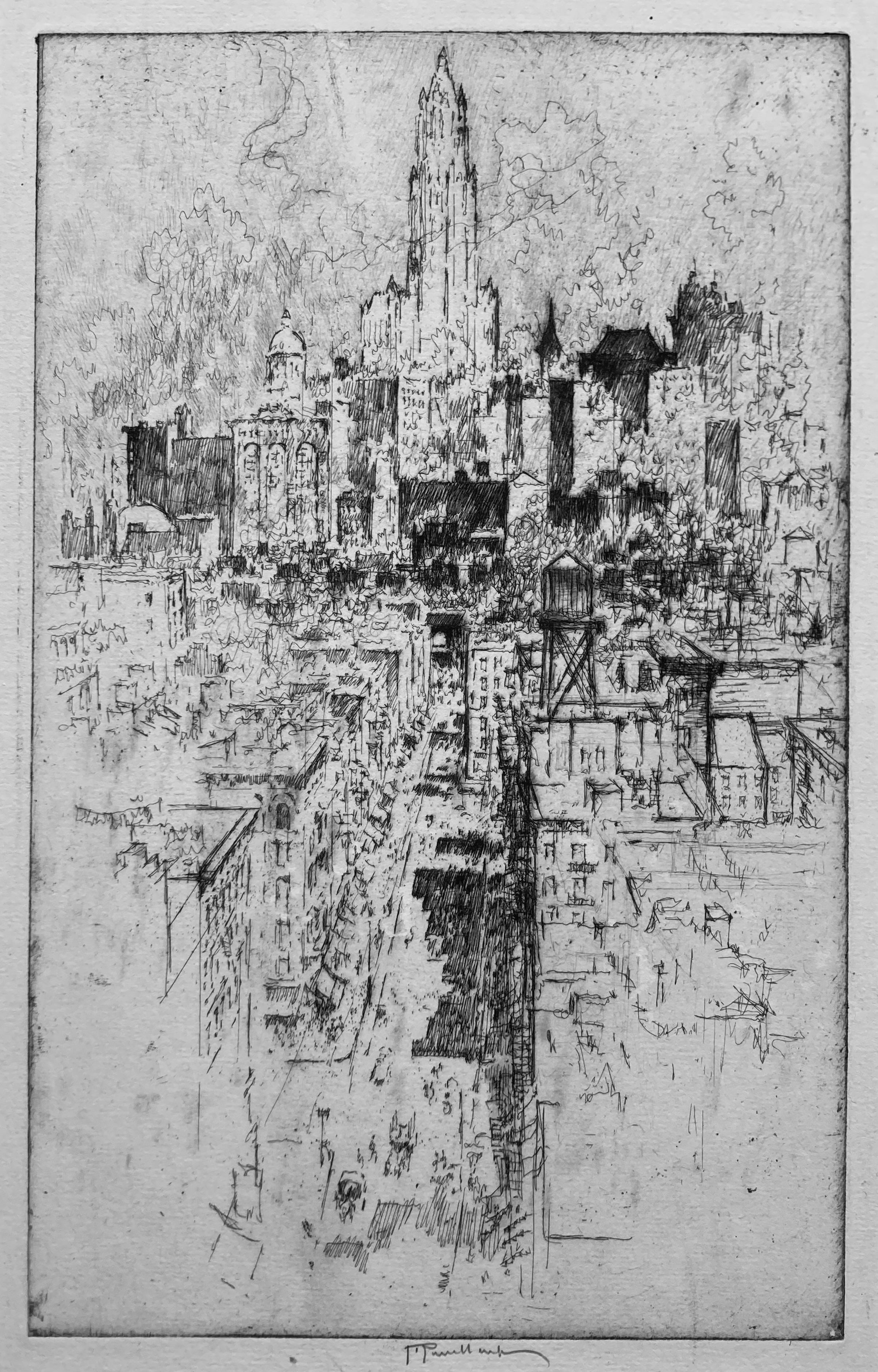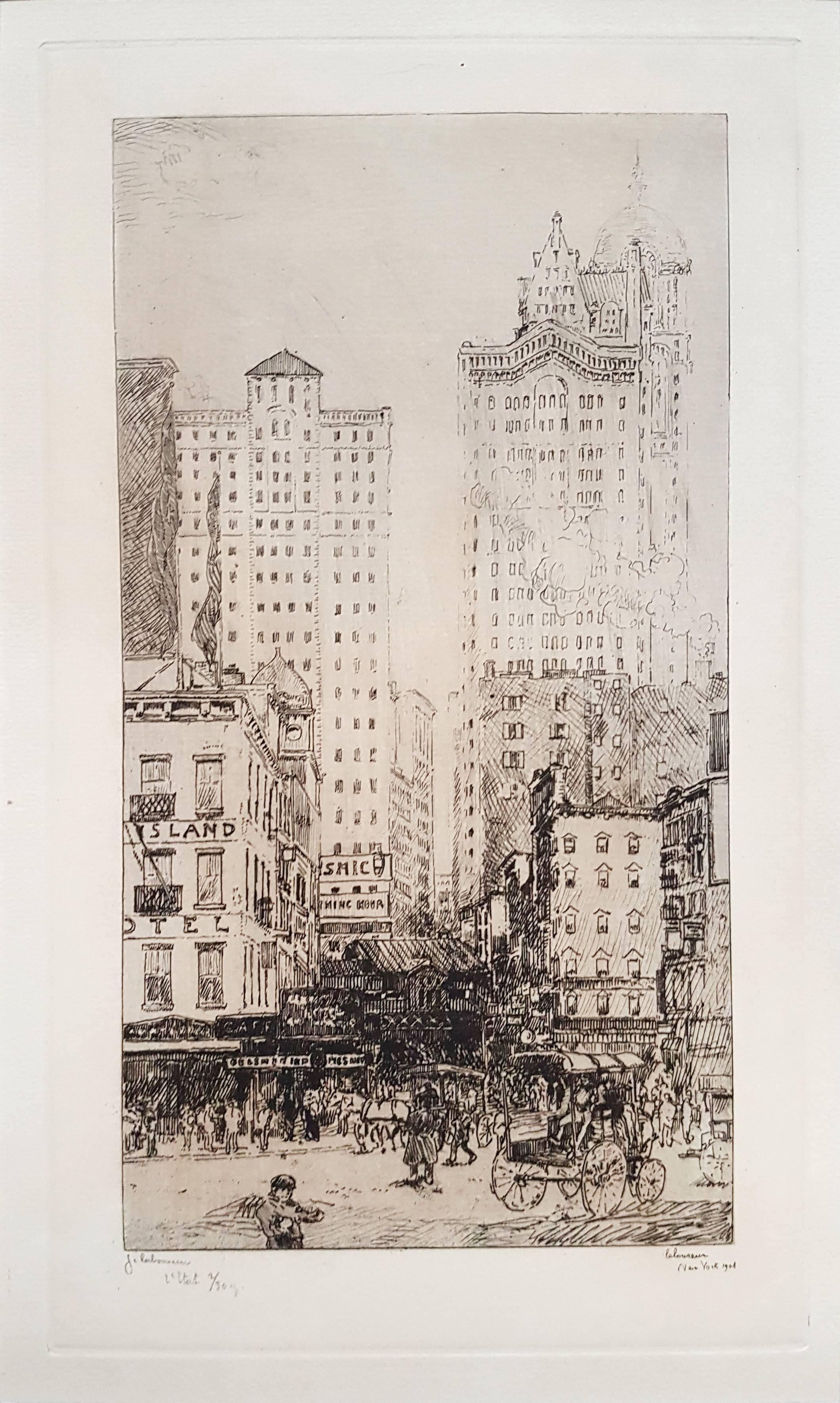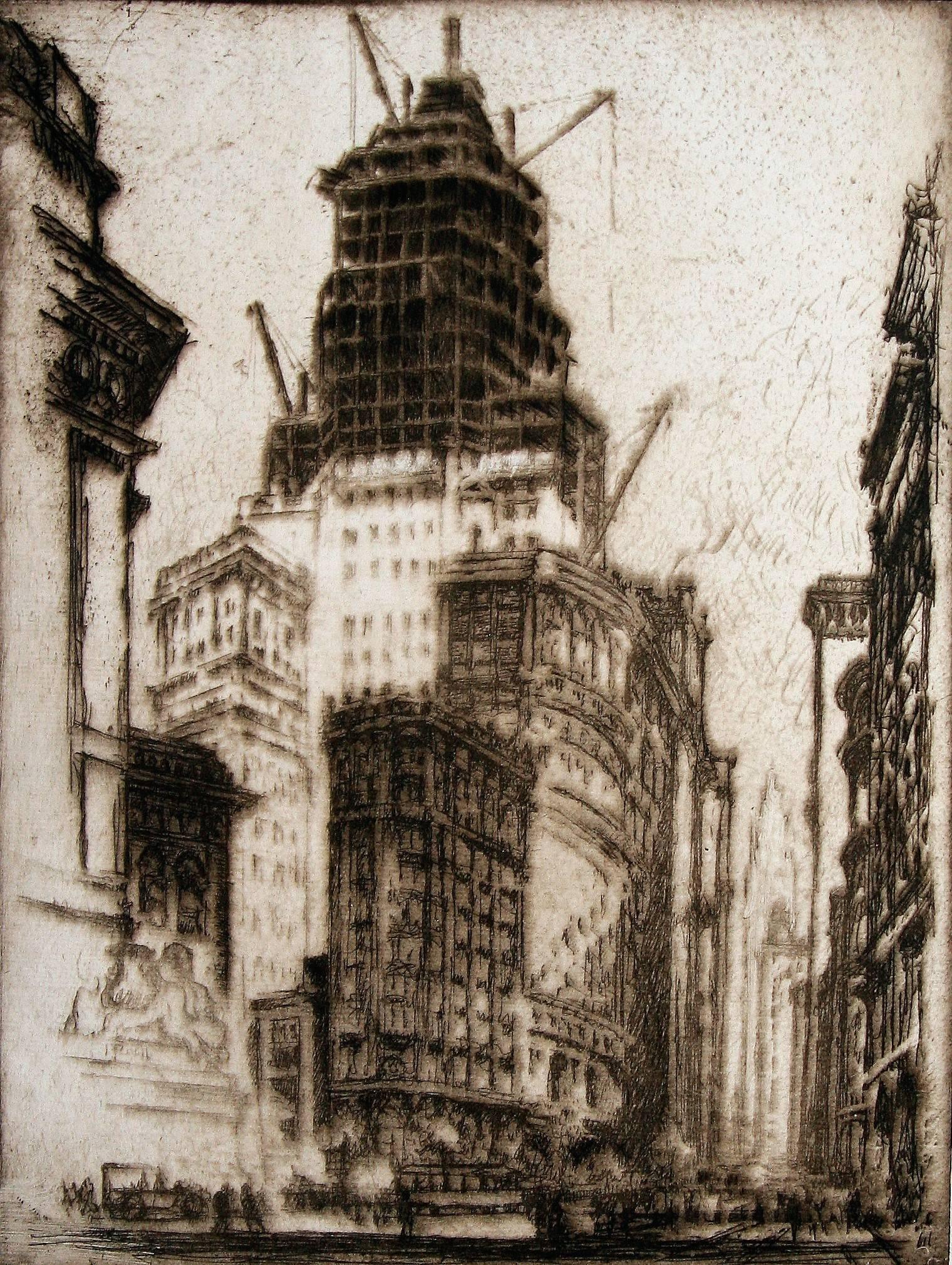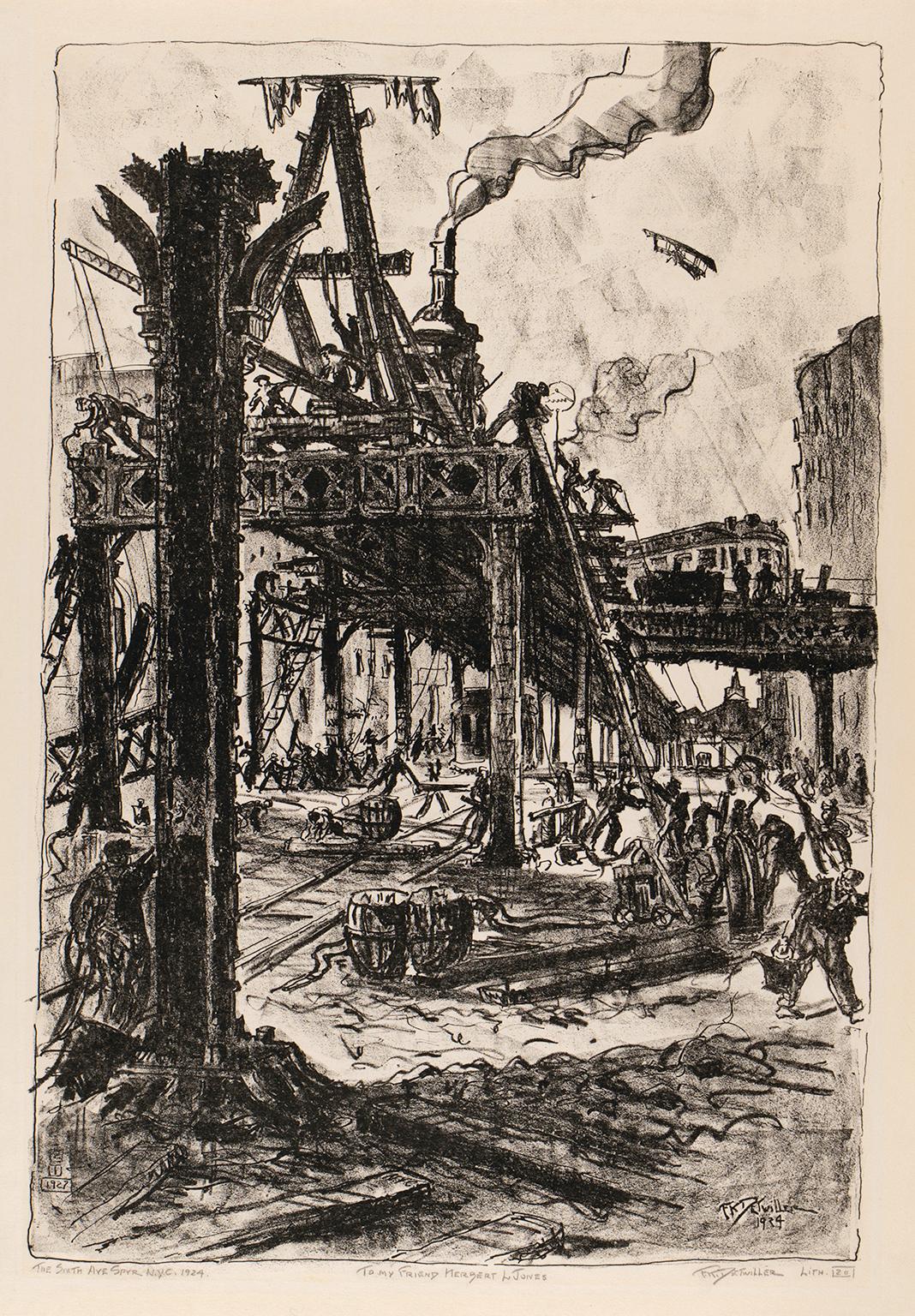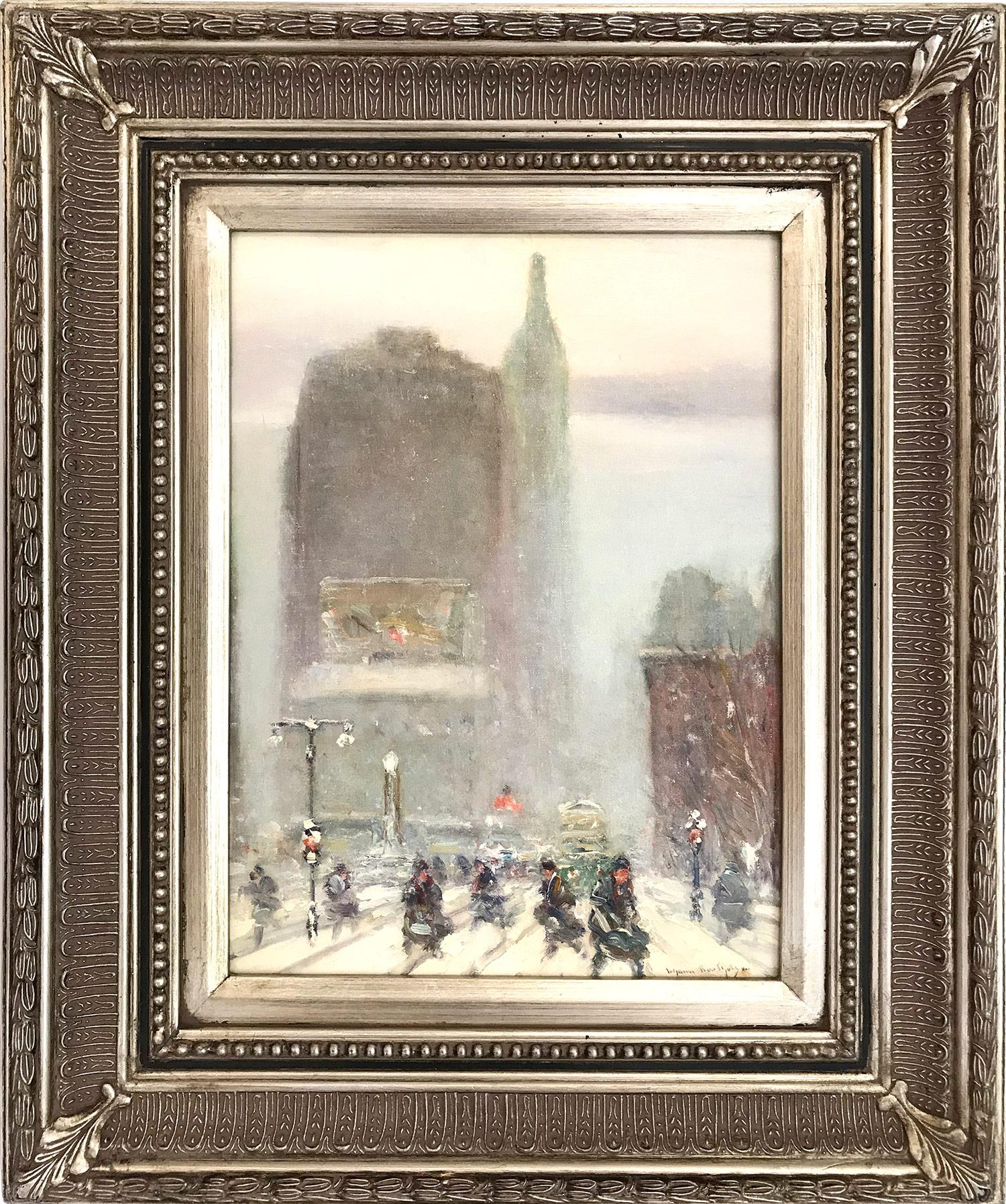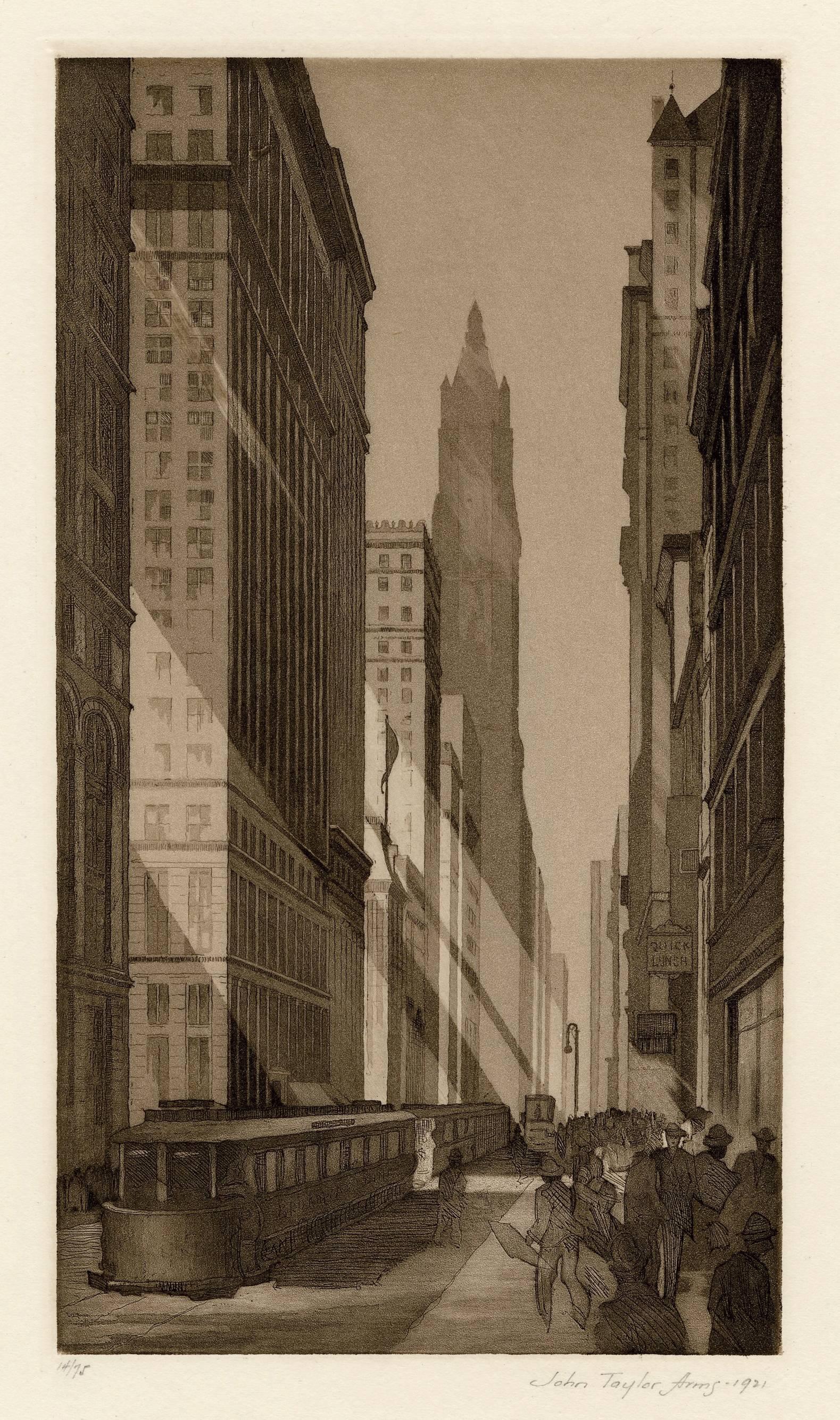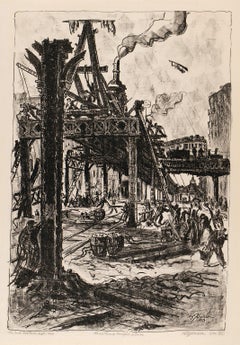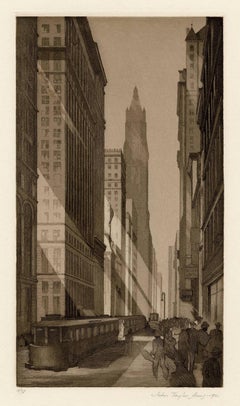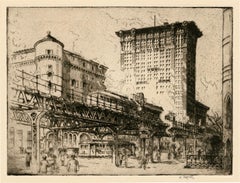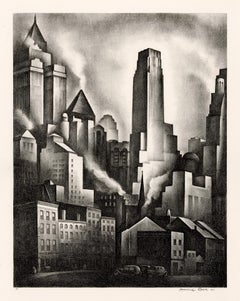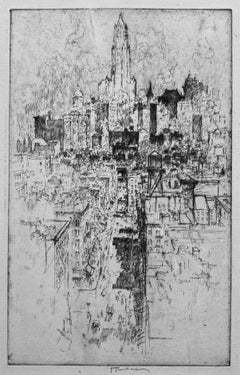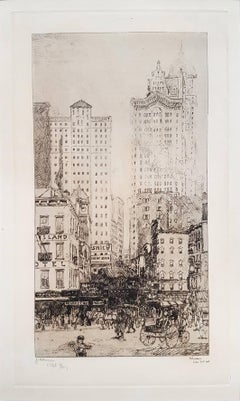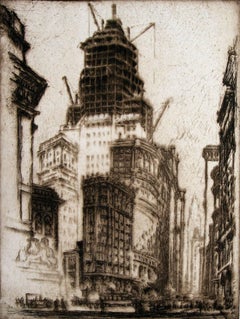Items Similar to Broad Street (Wall Street)
Want more images or videos?
Request additional images or videos from the seller
1 of 3
Bror Julius Olsson NordfeldtBroad Street (Wall Street)c. 1915
c. 1915
$1,200
£919.50
€1,057.64
CA$1,715.56
A$1,863.41
CHF 986.52
MX$22,499.57
NOK 12,315.72
SEK 11,667.19
DKK 7,897.34
About the Item
B.J.O. Nordfeldt, 'Broad Street (Wall Street)', etching, edition not stated, c. 1915. Signed in pencil. A superb impression, with rich burr, selectively wiped plate tone, and inky plate edges, on cream wove paper; the full sheet with margins (3/4 to 1 1/4 inches), in excellent condition. Printed by the artist. Matted to museum standards, unframed.
Impressions of this work are in the permanent collections of the Fine Arts Museums of San Francisco, Princeton University, Smithsonian American Art Museum.
A view looking down Broad Street past the New York Stock Exchange Building on the right with the columned Federal Hall building on the left. The image was drawn and etched by the artist as viewed and consequently printed as a mirror image of the actual street view.
ABOUT THE ARTIST
A solo exhibition of Nordfeldt’s etchings and woodcuts was presented by the Smithsonian Institution in 1926. In 1920, Nordfeldt had a one-man show at the Chicago Arts Club. In 1926, he won the bronze medal at the sesquicentennial exposition in Philadelphia and the Logan Medal at the Art Institute of Chicago. In 1927, he won the first annual prize from the Brooklyn Society of Etchers, and the following year he won first prize from the Chicago Society of Etchers. In 1929, Nordfeldt had a one-man show at the Denver Art Museum.
Nordfeldt's work is held in numerous museum collections including Amon Carter Museum of Western Art, Ft. Worth; Anschutz Collection, Denver; Art Institute of Chicago; Biblioteque d’Art et d’Archeologie, Paris; British Museum, London; Corcoran Gallery of Art, Washington, DC; Los Angeles County Museum; Metropolitan Museum of Art, New York City; Museum of Fine Arts, Santa Fe; National Museum of American Art, Smithsonian Institution, Washington, DC; National Gallery, Sydney, Australia; Phillips Collection, Washington, DC.
- Creator:Bror Julius Olsson Nordfeldt (1878-1955, American)
- Creation Year:c. 1915
- Dimensions:Height: 13.75 in (34.93 cm)Width: 7.88 in (20.02 cm)
- Medium:
- Movement & Style:
- Period:
- Condition:
- Gallery Location:Myrtle Beach, SC
- Reference Number:Seller: 1019541stDibs: LU53234502371
About the Seller
5.0
Recognized Seller
These prestigious sellers are industry leaders and represent the highest echelon for item quality and design.
Platinum Seller
Premium sellers with a 4.7+ rating and 24-hour response times
Established in 1995
1stDibs seller since 2016
322 sales on 1stDibs
Typical response time: 1 hour
Associations
International Fine Print Dealers Association
- ShippingRetrieving quote...Shipping from: Myrtle Beach, SC
- Return Policy
Authenticity Guarantee
In the unlikely event there’s an issue with an item’s authenticity, contact us within 1 year for a full refund. DetailsMoney-Back Guarantee
If your item is not as described, is damaged in transit, or does not arrive, contact us within 7 days for a full refund. Details24-Hour Cancellation
You have a 24-hour grace period in which to reconsider your purchase, with no questions asked.Vetted Professional Sellers
Our world-class sellers must adhere to strict standards for service and quality, maintaining the integrity of our listings.Price-Match Guarantee
If you find that a seller listed the same item for a lower price elsewhere, we’ll match it.Trusted Global Delivery
Our best-in-class carrier network provides specialized shipping options worldwide, including custom delivery.More From This Seller
View All'The Sixth Avenue Spur, New York City '— American Expressionism
By Frederick K. Detwiller
Located in Myrtle Beach, SC
Frederick K. Detwiller, 'The Sixth Avenue Spur, New York City', lithograph, 1924, edition 20. Signed, dated, titled, and annotated 'Lith 20' in pencil. Inscribed 'To my Friend Herbert L. Jones' in pencil. Signed and dated, in the stone, lower right; initialed and dated '1927' in the stone, lower left. A fine, richly-inked impression, on cream wove paper, with margins (7/8 to 1 1/4 inches); slight toning in the top left sheet edge, otherwise in good condition. Scarce.
Image size 20 1/2 x 14 inches (521 x 356 mm); sheet size 22 1/2 x 16 inches (572 x 406 mm). Archivally matted to museum standards, unframed.
ABOUT THE IMAGE
The Sixth Avenue El was constructed in the late 1870s by the Gilbert Elevated Railway and reorganized as the Metropolitan Elevated Railway. By 1878, it was running from Rector Street to 58th Street. Soon after that, it was taken over by the Manhattan Railway Company, with three other Manhattan elevated train lines. The company built a connection, the ‘spur’ by which it turned west on 53rd Street to merge with the 9th Avenue El—paralleling the present-day route of the 6th Avenue subway.
The Sixth Avenue El served the “Ladies Mile” shops (including the Siegel-Cooper emporium, whose building now houses Bed...
Category
1920s Ashcan School Figurative Prints
Materials
Lithograph
'Downtown, New York' — 1920s Modernism
By John Taylor Arms
Located in Myrtle Beach, SC
John Taylor Arms, 'Downtown, New York', etching with aquatint, 1921, edition 75, Fletcher 108. Signed, dated, and numbered 14/75 in pencil.
A superb, finely nuanced impression, in d...
Category
Early 20th Century American Modern Landscape Prints
Materials
Etching
'The Elevated, East 42nd Street, New York' — 1910 American Realism
By William Monk
Located in Myrtle Beach, SC
William Monk, 'The Elevated, East 42nd Street, New York', etching, 1910. Signed in pencil and titled in the bottom right sheet corner. Signed in the plate, lower right. A superb, ric...
Category
1910s American Realist Figurative Prints
Materials
Etching
$1,200 Sale Price
20% Off
'Financial District', New York City — American Modernism
By Howard Norton Cook
Located in Myrtle Beach, SC
Howard Cook, 'Financial District', lithograph, 1931, edition 75, Duffy 155. A fine, richly-inked impression, on cream wove paper, the full sheet with wide margins (2 3/4 to 5 5/8 inches), in excellent condition. Image size 13 5/16 x 10 3/8 inches (338 x 264 mm); sheet size 23 x 16 inches (584 x 406 mm). Matted to museum standards, unframed.
Literature: 'American Master Prints from the Betty and Douglas Duffy Collection', the Trust for Museum Exhibitions, Washington, D.C., 1987.
Collections: Crystal Bridges Museum of American Art, Library of Congress, Metropolitan Museum of Art, Philadelphia Museum of Art, Smithsonian American Art Museum.
ABOUT THE ARTIST
Howard Norton Cook (1901-1980) was one of the best-known of the second generation of artists who moved to Taos. A native of Massachusetts, he studied at the Art Students League in New York City and at the Woodstock Art Colony. Beginning his association with Taos in 1926, he became a resident of the community in the 1930s. During his career, he received two Guggenheim Fellowships and was elected an Academician in the National Academy of Design. He earned a national reputation as a painter, muralist, and printmaker.
Cook’s work in the print mediums received acclaim early in his career with one-person exhibitions at the Denver Art Museum (1927) and the Museum of New Mexico (1928). He received numerous honors and awards over the years, including selection in best-of-the-year exhibitions sponsored by the American Institute of Graphics Arts, the Brooklyn Museum, the Society of American Etchers, and the Philadelphia Print Club. His first Guggenheim Fellowship took him to Taxco, Mexico in 1932 and 1933; his second in the following year enabled him to travel through the American South and Southwest.
Cook painted murals for the Public Works of Art Project in 1933 and the Treasury Departments Art Program in 1935. The latter project, completed in Pittsburgh, received a Gold Medal from the Architectural League of New York. One of his most acclaimed commissions was a mural in the San Antonio Post Office in 1937.
He and Barbara Latham settled in Talpa, south of Taos, in 1938 and remained there for over three decades. Cook volunteered in World War II as an Artist War Correspondent for the US Navy, where he was deployed in the Pacific. In 1943 he was appointed Leader of a War Art Unit...
Category
1930s American Modern Figurative Prints
Materials
Lithograph
'Manhattan Old and New' — Vintage New York Cityscape
By Samuel Chamberlain
Located in Myrtle Beach, SC
Samuel Chamberlain, 'Manhattan Old and New', drypoint, 1929, edition 100, Chamberlain and Kingsland 81. Signed, titled, and numbered '81/100' in pencil. Titled and annotated '30.00' in pencil, in the artist's hand, bottom margin. Matted to museum standards, unframed.
A superb, finely-detailed impression, with selectively wiped plate tone, on heavy Rives cream wove paper; full margins (1 1/2 to 2 1/4 inches), in excellent condition.
The subject of the print is the lower Manhattan cityscape just before the Depression.
Image size 8 3/4 x 6 13/16 inches (222 x 173 mm); sheet size 12 3/4 x 10 inches (324 x 254 mm).
Impressions of this work are held in the collections of the National Gallery of Art and the Zimmerli Art Museum.
ABOUT THE ARTIST
'There is something about the atmospheric vibrancy of an etching which imparts a peculiar and irresistible life to architectural drawing...A copper plate offers receptive ground to the meticulously detailed drawing which so often appeals to the architect'. —Samuel Chamberlain, from the Catalogue Raisonné of his prints.
Samuel V. Chamberlain (1896 - 1975), printmaker, photographer, author, and teacher, was born in Iowa. His family moved to Aberdeen, Washington in 1901, and in 1913, Chamberlain enrolled in the University of Washington in Seattle, where he studied architecture under Carl Gould. By 1915, he was enrolled in the School of Architecture of the Massachusetts Institute of Technology in Boston. With the United States' involvement in the First World War, Chamberlain sailed to France, where he volunteered in the American Field Service. In 1918, he was transferred to the United States Army to complete his tour of duty. After the war, he returned to Boston and resumed his architectural studies, which he eventually discontinued, working for a few years as a commercial artist.
Chamberlain received the American Field Service Scholarship in 1923, which he used to travel to Spain, North Africa, and Italy. In 1924 he was living in Paris, where he studied lithography with Gaston Dorfinant and etching and drypoint with Edouard Léon, publishing his first etching the following year. In 1927, he studied drypoint with Malcolm Osborne...
Category
1920s American Modern Landscape Prints
Materials
Drypoint
Bowling Green, New York
By Louis Conrad Rosenberg
Located in Myrtle Beach, SC
Louis Conrad Rosenberg, 'Bowling Green, New York', etching, 1940. Signed in pencil. A superb, richly-inked impression, with all the fine lines printing c...
Category
1940s American Realist Figurative Prints
Materials
Drypoint
You May Also Like
UP TO THE WOOLWORTH
By Joseph Pennell
Located in Santa Monica, CA
JOSEPH PENNELL (1857- 1926)
UP TO THE WOOLWORTH 1915 (Wuerth 673)
Etching, signed in pencil. Early state before additional work, especially before extensive darkening in the sky. I...
Category
1910s American Impressionist Landscape Prints
Materials
Etching
New York, Courtland Street
By Jean-Emile Laboureur
Located in Roma, IT
Etching, 1908.
Image Dimensions: 30 x 17 cm
Hand signed and signed on plate.
Provenance: Galleria Prandi 26/10/1976.
Jean-Émile Laboureur was a French painter, illustrator and engra...
Category
Early 1900s Realist Landscape Prints
Materials
Etching
$4,544 Sale Price
30% Off
Standard Oil Building.
By Joseph Pennell
Located in Storrs, CT
Standard Oil Building. 1923. Etching. Wuerth 817. 12 1/4 x 9 1/4 (sheet 13 1/2 x 10 1/16). Edition probably 50. A glowing impression, printed by the artist on antique cream wove paper. Signed and annotated 'imp' in pencil. Housed in a 20 x 16-inch archival mat
proof printed by the artist. $875.
26 Broadway" is the home of the Standard Oil...
Category
Early 20th Century American Modern Landscape Prints
Materials
Etching
"Madison Square on 5th Avenue and 23rd Street" Impressionist Winter Street Scene
By Johann Berthelsen, 1883-1972
Located in New York, NY
A truly stunning jewel and pertinent example of Berthelsen's charming New York City winter scenes depicting Madison Square Park on 5th Avenue and 23rd Street. An iconic scene that so...
Category
Mid-20th Century American Impressionist Landscape Paintings
Materials
Canvas, Oil, Board
St. Paul’s From John Street, NY
By Felicie Howell
Located in Milford, NH
A fine cityscape painting by American artist Felicie Waldo Howell (1897-1968). Howell was born in Hawaii, moved to Washington DC to study at the Corcoran School of Art with E.C. Messer, then enrolled at the Philadelphia School of Design for Women in Pennsylvania, studying with Henry Snell. She became well known as a painter of oils and watercolors, most known for coastal landscapes, shore scenes, impressionist figures in nature...
Category
1920s American Impressionist Landscape Paintings
Materials
Canvas, Oil
Wall Street New York
By Gail Sherman Corbett
Located in Saratoga Springs, NY
Signed lower right.
Category
Mid-20th Century American Impressionist Figurative Paintings
Materials
Canvas, Oil
More Ways To Browse
Vintage Brooklyn Sign
Watch Lot
A Chorus Line
Antique Anatomical Drawings
Antique Goddess Painting
Bacardi Vintage
Bronze Patina Horse Sculpture
Bronze Sculpture Dress
Dominique Polles
Dr Seuss Vintage
Feather Art Birds
Francesca Bernardini
Hippo Sculptures
Horse Watch
Italian Villa Paintings
Jordi Bonet
Lucite Kinetic Art
Mother And Infant
